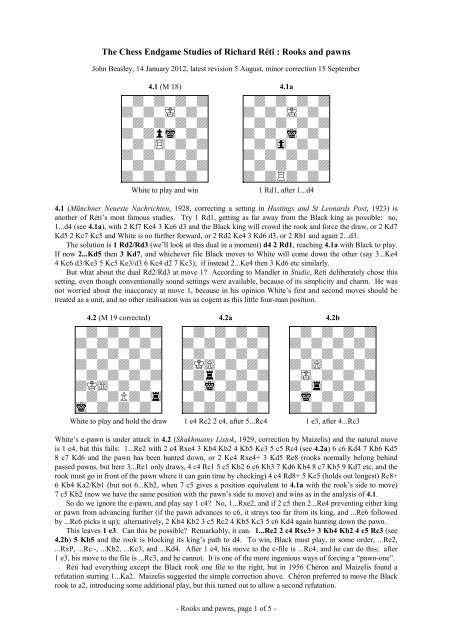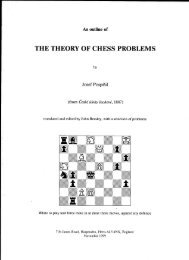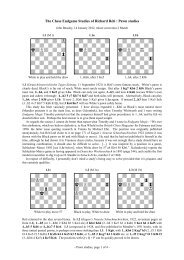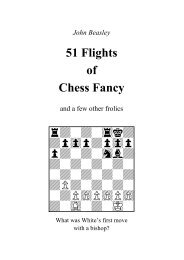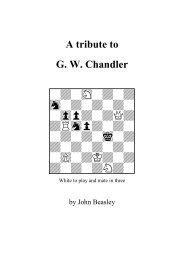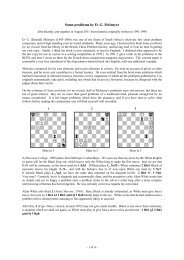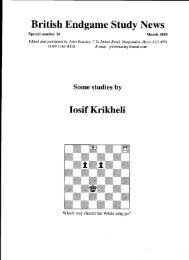The Chess Endgame Studies of Richard Réti - JSB
The Chess Endgame Studies of Richard Réti - JSB
The Chess Endgame Studies of Richard Réti - JSB
You also want an ePaper? Increase the reach of your titles
YUMPU automatically turns print PDFs into web optimized ePapers that Google loves.
<strong>The</strong> <strong>Chess</strong> <strong>Endgame</strong> <strong>Studies</strong> <strong>of</strong> <strong>Richard</strong> <strong>Réti</strong> : Rooks and pawns<br />
John Beasley, 14 January 2012, latest revision 5 August, minor correction 15 September<br />
4.1 (M 18) 4.1a<br />
wdwdwdwd wdwdwdwd<br />
dwdwIwdw dwdwIwdw<br />
wdwdwdwd wdwdwdwd<br />
dwdpiwdw dwdwiwdw<br />
wdw$wdwd wdw0wdwd<br />
dwdwdwdw dwdwdwdw<br />
wdwdwdwd wdwdwdwd<br />
dwdwdwdw dwdRdwdw<br />
White to play and win 1 Rd1, after 1...d4<br />
4.1 (Münchner Neueste Nachrichten, 1928, correcting a setting in Hastings and St Leonards Post, 1923) is<br />
another <strong>of</strong> <strong>Réti</strong>’s most famous studies. Try 1 Rd1, getting as far away from the Black king as possible: no,<br />
1...d4 (see 4.1a), with 2 Kf7 Ke4 3 Ke6 d3 and the Black king will crowd the rook and force the draw, or 2 Kd7<br />
Kd5 2 Kc7 Kc5 and White is no further forward, or 2 Rd2 Ke4 3 Kd6 d3, or 2 Rh1 and again 2...d3.<br />
<strong>The</strong> solution is 1 Rd2/Rd3 (we’ll look at this dual in a moment) d4 2 Rd1, reaching 4.1a with Black to play.<br />
If now 2...Kd5 then 3 Kd7, and whichever file Black moves to White will come down the other (say 3...Ke4<br />
4 Kc6 d3/Ke3 5 Kc5 Ke3/d3 6 Kc4 d2 7 Kc3); if instead 2...Ke4 then 3 Kd6 etc similarly.<br />
But what about the dual Rd2/Rd3 at move 1? According to Mandler in Studie, <strong>Réti</strong> deliberately chose this<br />
setting, even though conventionally sound settings were available, because <strong>of</strong> its simplicity and charm. He was<br />
not worried about the inaccuracy at move 1, because in his opinion White’s first and second moves should be<br />
treated as a unit, and no other realisation was as cogent as this little four-man position.<br />
4.2 (M 19 corrected) 4.2a 4.2b<br />
wdwdwdwd wdwdwdwd wdwdwdwd<br />
dwdwdwdw dwdwdwdw dwdwdwdw<br />
wdwdwdwd wdwdwdwd wdwdwdwd<br />
dwdwdwdw dK)wdwdw dw)wdwdw<br />
wdwdwdwd wdrdwdwd wIwdwdwd<br />
dK)wdwdw dwiwdwdw dw4wdwdw<br />
wdwdPdw4 wdwdwdwd wiwdwdwd<br />
iwdwdwdw dwdwdwdw dwdwdwdw<br />
White to play and hold the draw 1 e4 Re2 2 c4, after 5...Rc4 1 e3, after 4...Rc3<br />
White’s e-pawn is under attack in 4.2 (Shakhmatny Listok, 1929, correction by Maizelis) and the natural move<br />
is 1 e4, but this fails: 1...Re2 with 2 c4 Rxe4 3 Kb4 Kb2 4 Kb5 Kc3 5 c5 Rc4 (see 4.2a) 6 c6 Kd4 7 Kb6 Kd5<br />
8 c7 Kd6 and the pawn has been hunted down, or 2 Kc4 Rxe4+ 3 Kd5 Re8 (rooks normally belong behind<br />
passed pawns, but here 3...Re1 only draws, 4 c4 Rc1 5 c5 Kb2 6 c6 Kb3 7 Kd6 Kb4 8 c7 Kb5 9 Kd7 etc, and the<br />
rook must go in front <strong>of</strong> the pawn where it can gain time by checking) 4 c4 Rd8+ 5 Kc5 (holds out longest) Rc8+<br />
6 Kb4 Ka2/Kb1 (but not 6...Kb2, when 7 c5 gives a position equivalent to 4.1a with the rook’s side to move)<br />
7 c5 Kb2 (now we have the same position with the pawn’s side to move) and wins as in the analysis <strong>of</strong> 4.1.<br />
So do we ignore the e-pawn, and play say 1 c4? No, 1...Rxe2, and if 2 c5 then 2...Re4 preventing either king<br />
or pawn from advancing further (if the pawn advances to c6, it strays too far from its king, and ...Re6 followed<br />
by ...Rc6 picks it up); alternatively, 2 Kb4 Kb2 3 c5 Rc2 4 Kb5 Kc3 5 c6 Kd4 again hunting down the pawn.<br />
This leaves 1 e3. Can this be possible? Remarkably, it can. 1...Re2 2 c4 Rxe3+ 3 Kb4 Kb2 4 c5 Rc3 (see<br />
4.2b) 5 Kb5 and the rook is blocking its king’s path to d4. To win, Black must play, in some order, ...Re2,<br />
...RxP, ...Rc~, ...Kb2, ...Kc3, and ...Kd4. After 1 e4, his move to the c-file is ...Rc4, and he can do this; after<br />
1 e3, his move to the file is ...Rc3, and he cannot. It is one <strong>of</strong> the more ingenious ways <strong>of</strong> forcing a “pawn-one”.<br />
<strong>Réti</strong> had everything except the Black rook one file to the right, but in 1956 Chéron and Maizelis found a<br />
refutation starting 1...Ka2. Maizelis suggested the simple correction above. Chéron preferred to move the Black<br />
rook to a2, introducing some additional play, but this turned out to allow a second refutation.<br />
- Rooks and pawns, page 1 <strong>of</strong> 5 -
- <strong>The</strong> chess endgame studies <strong>of</strong> <strong>Richard</strong> <strong>Réti</strong> -<br />
4.3 (M 20) 4.3a 4.3b<br />
wdwdwdwd wdwdwdwd wdwdwdwd<br />
dwdwdw0w dwdwdw0w dwdwdw0w<br />
wdwdwdwd wdwdwdwd wdwdwdwd<br />
dwdwdw0w dwdwdw0w dwdwdw0w<br />
wdwdKdw0 wdwdwdwd wdwdwdwd<br />
dwdwdwdk dwdwdwIw dwdwdKdw<br />
wdwdw$wd wdw$wdw0 wdw$wdwd<br />
dwdwdwdw dwdwdwiw dwdwdwin<br />
White to play and win After 6 Kg3 After 7 Kf3<br />
4.3 (Tijdschrift v. d. NSB, 1922, correction) is a puzzler. Try 1 Ke3: no, 1...Kg3 2 Rf5 g4 3 Ke2 h3 4 Kf1 Kh2<br />
5 Rg5 g3 6 Rg6 g2+ 7 Kf2 Kh1 with a draw. Try 1 Rf5, when 1...g4 2 Kf4 g3 3 Kf3 Kh2 4 Rg5 wins: yes, but<br />
1...Kg4 2 Rf1 Kg3 3 Rg1+ Kf2 4 Rd1 h3 5 Kf5 Kg3 (but not 5...h2, when 6 Kg4 wins) 6 Rd3+ Kh4 7 Rd4+ Kg3<br />
holds out. <strong>The</strong> only move to win is 1 Rd2 (the reason for choosing the d-file will appear), and the main line<br />
defence is 1...Kg3. Nothing else is better; if 1...g6 then 2 Kf3 g4+ 3 Kf2 Kh2 4 Kf1+ Kh1 5 Rd4 etc, and<br />
Mandler also gives 1...g4 2 Ke3 with 2...g5 3 Rd4 Kg3 4 Ke2 h3 5 Kf1 or 2...Kg3 3 Ke2 Kg2 4 Rd4.<br />
After 1...Kg3, play continues 2 Rd3+ Kg2 (or 2...Kg4 3 Ke3 Kg3 4 Ke2+ Kg2 5 Rd4 Kg3 6 Rd7 etc) 3 Kf5<br />
h3 4 Kg4 h2 5 Rd2+ Kg1 6 Kg3 threatening mate (see 4.3a), and only 6...h1N+ <strong>of</strong>fers hope. Now 7 Kf3 gives<br />
4.3b, and we see why the rook had to go to the d-file at move 1; if it were on any other file, Black could escape<br />
by 7...g4+ 8 Kxg4 Nf2+ 9 Kf3 Nd3. As it is, however, the knight will have to go back to h1 (9...Nh3 would be<br />
met by 10 Kg3 attacking it and threatening mate), and White will win. <strong>The</strong> move that holds out longest from<br />
4.3b is in fact 7...g6, after which White repeatedly loses a move to bring the g-pawns forward: 8 Rg2+<br />
(simplest) Kf1 9 Rh2 Kg1 (9...g4+ 10 Kxg4 with 10...Nf2+ 11 Kf3 or 10...Kg1 11 Rd2) 10 Rd2 g4+ 11 Kxg4<br />
Nf2+ 12 Kf3 Nh1 13 Ra2 (say) g5 14 Rd2 etc.<br />
4.4 (M 21) 4.4a 4.4b<br />
wdw$wdwI wdwdwdwd wdwdwdwd<br />
dwdwdwdw dwdwdwdw dwdwdwdw<br />
wdwdwdwd wdwdwIwd wdwdwIwd<br />
dpiwdwdw dwdwdwdw dwdwdwdw<br />
wdwdw0pd wdwdwdwd wdwdwdwd<br />
dwdwdwdw dwdkdwdw dwdwiwdw<br />
wdwdwdwd w0wdw0wd w0wdwdpd<br />
dwdwdwdw dwdwdRdw dwdwdw$w<br />
White to play and hold the draw 1 Rf8, after 7...Kd3 1 Rg8, after 7 Ke3<br />
A study like 4.3 has a certain practical value, and the same will be true <strong>of</strong> 4.4 (composed in 1929, and first<br />
published in Mandler’s 1931 book). Try 1 Rf8: no, 1...f3 2 Rf4 b4 3 Rxg4 b3 4 Rg1 f2 5 Rf1 b2 6 Kg7 Kd4<br />
7 Kf6 Kd3 threatening 8...Kf2 (see 4.4a), and if White tries 8 Rb1 Black will play 8...Kc2 instead. Correct is<br />
1 Rg8, after which 1...g3 2 Rg4 b4 3 Rxf4 b3 4 Rf1 (White has unimportant alternatives from here onwards) g2<br />
5 Rg1 b2 6 Kg7 Kd4 7 Kf6 Ke3 gives 4.4b. Black again threatens to attack the rook and win it for the pawn,<br />
but White can counter by playing 8 Rb1 ready for 8...Kf2 9 Rxb2+; and if Black switches his attack to the other<br />
side, 8...Kd3, White plays 9 Rg1 and Black still cannot advance. If the pawns are only four files apart, they and<br />
their king can overwhelm the rook; if they are five files apart, they cannot.<br />
- Rooks and pawns, page 2 <strong>of</strong> 5 -
- <strong>The</strong> chess endgame studies <strong>of</strong> <strong>Richard</strong> <strong>Réti</strong> -<br />
4.5 (M 22) 4.5a 4.5b<br />
wdwdwdwd wdwdwdwd wdwdwdwd<br />
dwdwdwdw dwdwdwdw dwdwdwdw<br />
wdwdwdwd wdwdwdwd wdwdwdwd<br />
dwdwdkdw dwdwdwdw dwdwdwdw<br />
wdwdwdwd wdwdwdwd wdwdkdwd<br />
dwdwdwdw dwdkdwdw dwdwdwdw<br />
wdpdpdpd wdpdwdwd wdpdKdpd<br />
dw$wdwIw dw$wIwdw dwdw$wdw<br />
White to play and win 1 Kxg2, after 3...Kd3 Main line, after 4 Re1<br />
<strong>The</strong> natural move in 4.5 (Kölnische Volkszeitung, 1928) is 1 Kxg2, but it fails: 1...Ke4 2 Kf2 and now not<br />
2...Kd3, when 3 Ke1 would put Black in zugzwang and win easily (we would have 4.5a with an extra Black<br />
pawn on e2 but with Black to move), but 2...e1Q+ 3 Kxe1 (3 Rxe1 is no better, 3...Kd3 with ...Kd2 to follow)<br />
Kd3 (see 4.5a) and White can make no progress (4 K~ Kd2, 4 Ra1 Kc3 5 Rc1 Kd3 repeating). By sacrificing<br />
one <strong>of</strong> his two pawns, Black has transferred the burden <strong>of</strong> moving to White.<br />
<strong>The</strong> correct move is 1 Kf2 going for the e-pawn instead, and after 1...Ke4 2 Kxe2 Kd4 3 Rg1/Ra1<br />
(simplest) Ke4 (after 3...Kc3 White wins easily, 4 Rg1 K~ 5 Kd2 etc) 4 Re1 we have 4.5b. (Playing 3 Re1<br />
instead <strong>of</strong> 3 Ra1/Rg1 doesn’t forfeit the win, but it wastes time; after 3...Ke4 we have 4.5b with White to play,<br />
which isn’t what we want, but White can manoeuvre to lose a move and get back to the same position with Black<br />
to play.) From 4.5b, 4...Kd4 can be met by 5 Kd2 since the rook prevents the Black king from doubling back to<br />
support the g-pawn, and 4...Kf4 by 5 Kf2 similarly, but what about 4...Ke5? Obviously 5 Ke3, and if 5...Ke6<br />
then 6 Kd2+ Kf5 7 Rg1 and White mops up both pawns.<br />
4.6 (M 24) 4.6a 4.6b<br />
wiwdw4wd wdwdwdrd wdwdw4wd<br />
dPdwdwdw dwdwiwdw dwdwiwdw<br />
wdwdwdPd wdwdwdPd wdwdwdPd<br />
dwdwdwdw dwdwIwdw dwdwIw$w<br />
Kdwdwdwd wdwdwdwd wdwdwdwd<br />
dwdwdwdw dwdwdwdw dwdwdwdw<br />
wdwdwdwd wdwdwdwd wdwdwdwd<br />
dRdwdwdw dwdwdw$w dwdwdwdw<br />
White to play and win 1 Ka5, after 7...Ke7 Main line, after 6...Ke7<br />
In 4.6 (5th Honourable Mention, Tourney in honour <strong>of</strong> A. A. Troitzky, Zadachy i etyudy, 1929), an immediate<br />
king advance to support the b-pawn fails: 1 Ka5 Rf6 2 Rg1 (2 Rb6 Rxb6 3 Kxg6 stalemate) Rf8 3 Ka6 (3 Kb6<br />
Rf1 with a perpetual hounding <strong>of</strong> the rook) Rg8 4 Kb5 (4 Kb6 Rxg6+ 5 Rxg6 stalemate, 4 g7 Rxg7 5 Rxg7<br />
stalemate) Kxb7 5 Kc5 Kc7 6 Kd5 Kd7 7 Ke5 Ke7 (see 4.6a) 8 Kf5 Rf8+ 9 Kg5 Rf2/Rf3 with ...Kf8 to follow.<br />
Nor does 1 Rb6 work: 1...Rf1 (threat 2 Ra1+ K~ 3 Rb1+ K~ 4 Rxb6 Kxb6 stalemate) 2 Ka3 Rc1 3 Kb2 Rc5<br />
4 Kb3 Rc1 and the White king will stay shut in.<br />
To win, White must get his king across to support his g-pawn, and the way to start is 1 Rb5 threatening<br />
2 Kb4. 1...K~ 2 b8Q+ is routine and if 1...Rg8 then 2 Rb6 with 3 Kb5 to follow, leaving 1...Rf1 (for 2 Kb4 Rg1<br />
3 Rb6 Rb1+ 4 K~ Rxb6 5 Kxb6 stalemate) and 1...Rf6 attacking the pawn from the side. But in each case<br />
2 Rg5 forces 2...Rf8, and White’s king can advance: 3 Kb5/Kb4 Kxb7 4 Kc5 (now White must keep to the<br />
fifth rank) Kc7 5 Kd5 Kd7 6 Ke5 Ke7. This gives 4.6b, which differs from 4.6a in that Black’s rook is not yet<br />
on g8 and White’s rook is on the fifth rank. This allows White to play 7 Rf5, after which the Black rook must<br />
quit the file (7...Rxf5 8 Kxf5 is a routine win) and Black’s king will be cut <strong>of</strong>f from the pawn: 7...Rg8 8 Rf7+<br />
Ke8 9 Kf6 Kd8 10 g7 Ke8 11 Ke6 Kd8 12 Rf8+, or 7...Ra8 8 Rf7+ Ke8 9 Kf6 Ra6+ 10 Kg7 etc.<br />
- Rooks and pawns, page 3 <strong>of</strong> 5 -
- <strong>The</strong> chess endgame studies <strong>of</strong> <strong>Richard</strong> <strong>Réti</strong> -<br />
4.7 (M 25, version) 4.7a 4.7b<br />
wdkdwdwd wdkdwdwd wdkdwdwd<br />
dwdw4w0w 4wdwdw0w dw4wdw0w<br />
wIwdPdPd wdwdPdPd wIw$PdPd<br />
dwdwdw)w dwdRIw)w dwdwdw)w<br />
wdwdwdwd wdwdwdwd wdwdwdwd<br />
dwdwdwdw dwdwdwdw dwdwdwdw<br />
wdwdwdwd wdwdwdwd wdwdwdwd<br />
dwdRdwdw dwdwdwdw dwdwdwdw<br />
White to play and win White wins After 1...Rc7<br />
I give 4.7 (Národní listy, 5 May 1929, version) in the form quoted by Mandler in FIDE Revue 1957.<br />
<strong>The</strong> first point to note is that as long as the pawns are unmoved and Black’s king can reach e8, White cannot<br />
exchange rooks. For example, suppose 4.7 without the rooks. Even with the move, White cannot win; he can<br />
take the opposition by 1 Kc6, but after 1...Kd8 2 Kd6 Ke8 the normally winning move 3 e7 gives stalemate.<br />
Now consider diagram 4.7a. Suppose first that it is Black to play. 1...Rb7 2 Kd6 (threat 3 e7) Kd8<br />
(2...Rb6+ 3 Ke7 etc) 3 Kc6+, or 1...Rc7 2 Kd6 Kd8 3 Rf5 Rd7+ 4 Ke5 Rd1 5 Rf8+ Ke7 6 Rf7+ and 7 Rxg7, or<br />
1...Re7 2 Kd6 Kd8 3 Rf5 and the same. White to play, 1 Kf4 Ra4+ 2 Kf5 Ra7 3 Ke5 and we have transferred<br />
the move to Black, or 1...Re7 2 Rf5 Rxe6 (if 2...Kc7 then 3 Ke5 to stop 3...Kd6) 3 Rf7 Rxg6 4 Kf5 R~ 5 Rxg7.<br />
So 4.7a is a win for White with or without the move, which gives us a target. We must get White’s king to<br />
e5, and cannot clear his path by opposing rooks because Black will exchange with a draw. 1 Re1 can be shown<br />
to lead nowhere, and the main line goes 1 Rd6 Rc7 (see 4.7b) 2 Kb5 Ra7 (2...Kb6 3 Rd8 Re7 4 Rg8 Rc7 5 Rf8)<br />
3 Kc5 Ra5+ 4 Kb4 (see 4.7c) Ra7 (for 4...Re5 see below) 5 Kb5 Rc7 6 Kb6 (back to 4.7b but with Black to<br />
play) Re7 7 Kc5 Ra7 (now...Ra5+ is unavailable) 8 Rd4 Ra5+ 9 Kc6 Ra6+ 10 Kd5 (see 4.7d) Ra5+ (10...Kd8<br />
11 Ke5+ Ke8 12 Rd7 and once the g-pawn has fallen the win will not be far away) 11 Ke4 Ra6 12 Ke5 Ra5+<br />
13 Kf4 Ra7 14 Rd5 Ra4+ 15 Kf5 Ra7 16 Ke5. We have duly reached 4.7a, and the win follows as above.<br />
4.7c 4.7d 4.7e (M 25)<br />
wdkdwdwd wdkdwdwd wiwdwdwd<br />
dwdwdw0w dwdwdw0w dw4wdw0w<br />
wdw$PdPd rdwdPdPd wdw$PdPd<br />
4wdwdw)w dwdKdw)w dwdwdw)w<br />
wIwdwdwd wdw$wdwd wdwdwdwd<br />
dwdwdwdw dwdwdwdw Iwdwdwdw<br />
wdwdwdwd wdwdwdwd wdwdwdwd<br />
dwdwdwdw dwdwdwdw dwdwdwdw<br />
After 4 Kb4 After 10 Kd5 White to play and win (unsound)<br />
On the evidence <strong>of</strong> Harold van der Heijden’s “<strong>Endgame</strong> study database IV”, the study originally appeared in<br />
Národní listy with the g5 pawn on g4. Subsequently, either <strong>Réti</strong> or Mandler appears to have decided that Black<br />
could hold the draw in 4.7c by playing 4...Re5, thus refuting the lose-a-move manoeuvre and with it the intended<br />
solution. In Mandler’s 1931 book, therefore, the study appeared in the revised form 4.7e in which this supposed<br />
refutation was exploited in the play, the intended solution being 1 Ka4 Kc8 2 Kb4 Ra7 3 Kb5 etc and the natural<br />
try 1 Kb4 being defeated by 1...Kc8 2 Kb5 Ra7 3 Kc5 Ra5+ 4 Kb4 (else perpetual check on the a-file) Re5.<br />
Had this been sound, it would have been a masterpiece, the apparent reciprocal zugzwangs after 1 Kb4? Kc8<br />
2 Kb5 Ra7 and 1 Ka4! Kc8 2 Kb4 Ra7 3 Kb5 putting the final touch to an already fine composition. Sadly, the<br />
definitive results with K + R + 2P v K + R now available refute 4...Re5, the positions after 5 Rd7 Rxe6/Rxg5<br />
6 Rxg7 being won for White (specimen best-play lines are 5...Rxe6 6 Rxg7 Kd8 7 Kc5 Ra6 8 Kd5 Ke8 9 Rg8+<br />
Ke7 10 Ke5 Ra5+ 11 Kf4 Ra4+ 12 Kf5 Ra5+ 13 Kg4 Ra4+ 14 Kh5 Ra1 15 Rb8 Rh1+ 16 Kg4 Rg1+ 17 Kf5<br />
Rf1+ 18 Ke4 with 18...Rf8 19 Rb7+ Ke6 20 g7 or 18...Re1+ 19 Kd3 Rd1+ 20 Kc2 Rg1/Rd5 21 g7, and 5...Rxg5<br />
6 Rxg7 Kd8 7 Kc4 Ke8 8 Kd4 Rg1 9 Rg8+ Ke7 10 Ke5 Re1+ 11 Kf5 Re5+ 12 Kf4 Re1 {12...Rxe6 loses one<br />
move more quickly, 13 Kg5 Re1 14 Kh6 Rh1+ 15 Kg7 Rg1 16 Rh8 Ke6 17 Rh2} 13 Kg5 Rh1 14 Ra8 Rg1+<br />
15 Kh6 Rh1+ 16 Kg7 Rg1 17 Rh8 Kxe6 18 Rh2 Rg3 19 Re2+ Kd6 20 Kf7 Rf3+ 21 Kg8 Rg3 22 g7). So 4.7e<br />
collapses, 1 Kb4 becoming an unwanted dual rather than a tempting try, and we have to go back to 4.7. <strong>The</strong> fact<br />
that Mandler quoted 4.7 rather than 4.7e in 1957 suggests that he had worked this out before the computers did.<br />
- Rooks and pawns, page 4 <strong>of</strong> 5 -
- <strong>The</strong> chess endgame studies <strong>of</strong> <strong>Richard</strong> <strong>Réti</strong> -<br />
4.8 (M 26) 4.8a 4.8b<br />
wdwdw4wd wdwdwdwd wdwdwdwd<br />
dwdwdwdw dwdwdKdw dwdwdwIw<br />
wdwdw0w0 wdwdwdr0 wdwdwdw0<br />
dwdwdK0k dwdwdwdk dwdwdriw<br />
wdw$wdwd wdwdwdpd Pdwdwdpd<br />
dwdpdwdw dwdpdw)w dwdwdw)w<br />
PdwdwdPd Pdwdwdwd wdwdwdwd<br />
dwdwdwdw dRdwdwdw dRdwdwdw<br />
White to play and win After 5 Kf7 After 9...Kg5<br />
In 4.8 (Tijdschrift v. d. NSB 1922, version in Ostrauer Morgenzeitung, 6 February 1923, dedicated to Dr A.<br />
Mandler), 1 g3 threatens mate by 2 Rh4+ gxh4 3 g4, and the only realistic defence is 1...Rg8 (if instead 1...g4<br />
then 2 Rxg4 and mate by 3 Rh4). Now 2 Rb4 threatens mate by 3 Rb1 and 4 Rh1, and the only defence is<br />
2...g4. White still continues with 3 Rb1, but Black can give himself a little air by 3...Rg5+ 4 Kxf6 Rg6+ 5 Kf7.<br />
This has brought us to 4.8a, and we see that Black is not wholly out <strong>of</strong> the wood; a move by his rook along<br />
the rank will allow Rb5+ and mate next move, and ...Kg5 will allow mate at once. <strong>The</strong>re remains 5...d2, but<br />
6 a4 maintains the pressure (and its guard on b5 will be useful in the later play). Black still has no good rook or<br />
king move, but 6...d1Q 7 Rxd1 gets the pawn <strong>of</strong>f the board, and now 7...Rf6+ has become available because<br />
8 Kxf6 will be stalemate. Hence 8 Kg7, and if 8...Rg6+ then 9 Kh7 leaves Black helpless (he can avoid mate by<br />
9...Kg5 10 Rd5+ Kf6, but 11 Rd6+ then picks up the rook). But Black can play 8...Rf5 claiming the fifth rank<br />
for himself, and after 9 Rb1 Kg5 we have 4.8b.<br />
If now 10 Rb5, which was White’s objective in playing 9 Rb1, Black can reply 10...h5, and he will draw<br />
(11 Rxf5+ Kxf5 12 a5 h4 13 a6 hxg3 etc). <strong>The</strong> winning move is 10 Rb6, and if 10...h5 then 11 Rg6 gives mate.<br />
So Black moves his rook, say 10...Re5, and now White can play 11 Rb5. <strong>The</strong> exchange 11...Rxb5 12 axb5<br />
loses, White being a tempo ahead <strong>of</strong> the previous line, and if he moves his rook back to f5 or defends it by<br />
11...Kf5 White will win by exchanging it <strong>of</strong>f and taking the pawn on h6.<br />
4.9 (M 27) 4.9a 4.9b<br />
rdwdwdwd wdwdwdw4 wdwdwdw4<br />
0pIwdPdP 0pdwdPdP 0wdwdPdP<br />
wdwdwdwd wdwIwdwd wdpdKdwd<br />
dw)wdwdw dw)wdwdw dwiwdwdw<br />
wdwiwdwd wdwiwdwd wdwdwdwd<br />
dwdwdwdw dwdwdwdw dwdwdwdw<br />
Pdwdwdwd Pdwdwdwd Pdwdwdwd<br />
dwdwdwdw dwdwdwdw dwdwdwdw<br />
White to play and win 1 Kd6, after 1...Rh8 4 Ke6, after 4...Kc5<br />
White’s first thought in 4.9 (equal 1st/2nd Prize, Shakhmatny Listok, 1927/I) might be 1 Kxb7 with 2 c6 to<br />
follow, but it is soon seen to be inadequate. 1...Rh8 threatens 2...Rxh7 pinning the f-pawn, if 2 c6 then 2...Rxh7<br />
3 c7 Rxf7 with ...Rxc7 to follow, and if 2 Kc6 to avoid the pin then 2...Ke5 etc.<br />
So White must go the other way, and the natural move is 1 Kd6 guarding the c-pawn and avoiding the pin.<br />
But Black still plays 1...Rh8, and White has a problem (see 4.9a). Given that 2 Ke7 will be met by 2...Rxh7<br />
again pinning the pawn, his only chance appears to be 2 Ke6 going for the rook, but Black will play 2...Kxc5 and<br />
shadow him across: 3 Kf6 Kd6 4 Kg7 Ke7 5 Kxh8 Kxf7. White is now blocked in, and will be stalemated when<br />
his pawn moves have run out. Nor will sacrificing the c-pawn help (2 c6 bxc6 3 Ke6 Kc5 and exactly the same),<br />
and moves by the a-pawn can simply be echoed by Black.<br />
<strong>The</strong> way forward is 1 Kd7, and after 1...Rh8 then 2 Kd6 giving 4.9a with Black to play. 2...Ke4 is clearly<br />
hopeless (3 Ke6 Kd4 4 Kf6 Kd5 5 Kg7 Ke6 6 f8Q), but does not 2...Kc4 3 Ke6 Kxc5 lead to a draw as before?<br />
No, White can meet 2...Kc4 by 3 c6 (now sacrificing the c-pawn does help), and after 3...bxc6 not 4 Ke6,<br />
met by 4...Kc5 as before (see 4.9b), but 4 Ke5. Black must play 4...Kc5 to keep in touch, and 5 Ke6 gives 4.9b<br />
with Black to play. Moves by the a-pawn can be echoed by White, 5...a6 6 a3 a5 7 a4, and after 7...K~ we shall<br />
have 8 Kf6 Kd5 10 Kg7 Ke6 11 f8Q.<br />
It is one <strong>of</strong> <strong>Réti</strong>’s most subtle studies.<br />
- Rooks and pawns, page 5 <strong>of</strong> 5 -


